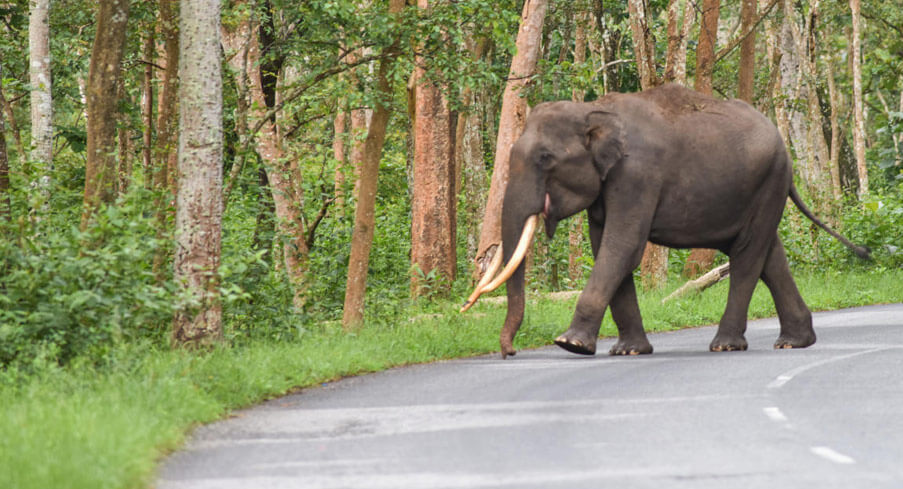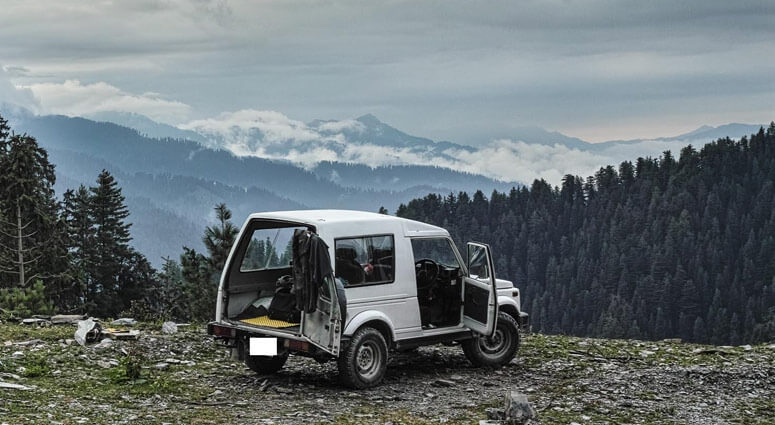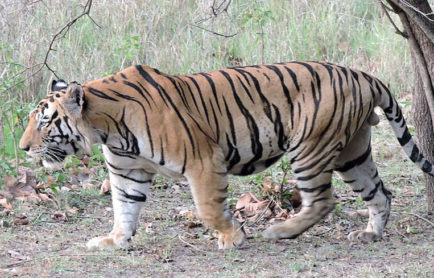Watch an Elephant Attack Safari Convoy: Awareness, Alertness & Things to Do in National Parks
 Published: 16 Mar, 2019By Ashwini
Published: 16 Mar, 2019By Ashwini

SUVs have forever ruled the roads of wildlife sanctuaries and whenever the urban animals wish to experience wild, they venture into wildlife sanctuaries and reserves. Helping them traverse across the wilderness are either SUV or minibus. In the category of Maruti Gypsy has been at the top of the chain. From being a flamboyant military vehicle to carrying wildlife enthusiasts across the forests of wildlife sanctuaries, this vehicle has always been the first choice for tour operators.
But recently news surfaced which said that an elephant attacked a convoy in Jim Corbett National Park. The trend of animals attacking an oncoming tourist convoy hasn’t been the first instance and it won’t be last either. The video of the incident surfaced on the internet and it seems to be uploaded by a wildlife enthusiast. Ever since the video gained social media traction, it has led to a debate about the responsibilities of the tourists and the organisers.
In the video, it can be seen that the sole elephant attacked on particular Gypsy, which it deemed dangerous. The story behind the incident is that one car came too close to the wild animal after one tourist requested that he wanted to click a selfie with the giant. Obliging to the request, the driver took the car close to the elephant, which proved dangerous for all the participants.
The elephant tried rolling the car several times and the tourists can be seen panicking, which shouldn’t be done in such situations. However, one point to note is that although the car suffered some damage, no major damage was caused to it. Some viewers even went onto suggest that the car bore the brunt of the attack without even flinching.
So, without much ado, let’s dissect the situation and figure out what went wrong and how can it be avoided in the future.
Why SUV’s are preferred, especially Gypsy?

The reason why SUVs are preferred is because of their adaptability to rugged terrains and off-roading capabilities. Maruti Gypsy has gone onto become the icon of wildlife safari. Thanks to its 4×4 off-roading capabilities, many organisers have been using this vehicle as their primary car for a wildlife safari. The car also runs on petrol, which reduces sound emissions as compared to diesel SUV.
What leads to the human-animal altercation?
Before going on a safari, you need to realise the fact that you are the one stepping into animal’s territory. You are the guest and you need to respect the hosts. From being quite inside the park to maintaining a low level of vehicle noise, it’s your responsibility to ensure that animals aren’t disturbed. This is the reason why there are limitations in Safari.
The major reason why an animal attacks is because it feels threatened by the external presence. The animal might be startled by the presence by the car and working on its instincts, the animal would probably approach you. However, the final outcome relies heavily on how we react to that situation. Panicking and shouting can cause further complications.
Past cases of Human-Animal altercation
Human-animal altercation in wildlife sanctuaries isn’t just limited to cases of animals damaging cars. Rather, there have been deadly instances, where either human or animal had to lose their lives.
- In January 2017 in China, it was reported that a man climbed a fence falling into the enclosure of a tiger in a zoo. He was mauled by the tiger and the man died.
- Another incident happened in 2018 on the 8th of May in Uganda. It was reported that a two-year old-boy was attacked by Leopard in the Queen Elizabeth National Park. The boy succumbed to the injuries.
- In May 2016, one incident took place at Cincinnati Zoo in the US. A three-year-old boy fell into a moat of a Gorilla named Harambe. It was witnessed that before carrying the little boy to dry land, the Gorilla dragged the kid through the water. Although the zoo authority managed to save the child, the Gorilla was shot dead in the rescue.
In Australia, it is being reported that Kangaroos attacks have become a common phenomenon. As per the reports published in the country, for the past few months, many cases have been reported where Kangaroos attacked visitors who wished to feed them.
Such cases aren’t limited to one country or region. As the number of wildlife safari enthusiasts increases every year, more trips in the jungles mean that the risk of human-animal altercation increases.
Who is at fault here?
While after any incident it’s very easy to point fingers at authority, we also need to take responsibility for our own irresponsible behaviour. In many cases, it’s our appetite for adventure which takes us closer to danger. The answer to the question is a little tricky as there isn’t just one reason which accounts for such accidents. From not following the rules of the park to taking rash decisions to poor service from the tour operator, there can be many reasons.
So, if you wish to avoid such incidents, there are certain do’s and don’ts you should stick to while visiting National Parks or any wildlife reserves.
Do’s and Don’ts…
Carefully listen to guidelines & instructions given by the Guide
We know there is a saying, “Rules are meant to be broken”, but this doesn’t apply to every case especially when you’re about to enter in the territory of wild animals. Your safety is the responsibility of guide and before starting any trip, he/she specifically mentions guidelines and instructions and it’s best if you listen to them and follow them. Your guide is more experienced in this environment and if he/she says anything, it’s for a reason. Respect the rules of the park and you will be safe.
Don’t ever step out your vehicle
Remember this rule, never ever in any circumstance are you to step out of your vehicle. The vehicle is the safest place to be and even in the case of an attack, your safari jeep is your best bet out of the danger. Scientists have shown that animals consider the vehicle as a single entity and even if you are in the car, the animal would attack the car. But the moment you step out of the car, you become the target and a pretty easy one for a wild beast.
Don’t try to go close to animals
Being adventurous and being stupid has got a very minor difference. One minute you might be adventurous and one wrong move and you will end up stupid. When surrounded by ferocious animals in their natural habitat, it is always better to be safe than sorry. Also, this doesn’t just apply for big cats and carnivores but also to animals like Deer, Zebra, Giraffe, Kangaroo. They might appear calm and friendly but they are equally dangerous, considering the size difference between you and them.
One of the major issues that have been creeping for a long time now is the selfie craze. This often leads to humans coming too close to animals. This can prove fatal to you. It’s always better to maintain a safe distance from these animals, for all the obvious reasons.
Don’t go for the road not taken
There have been tales of individuals who took the road and not taken and showed the world their talent. Well, this doesn’t apply when you are on a wildlife safari. Wherever you go on a wildlife safari tour, remember this one thing- always stick to the route and don’t venture into the unknown, at any cost. If you see anything interesting, don’t go looking for it alone. Whatever you do should be known to the tour guide and if the guide deems it to be dangerous, listen to him/her.
Keep calm and explore
Remember this one simple rule when in danger, keeping calm and losing your cool can literally be the difference between life and death. One of the many reasons why animals attack humans is because of human excitement. Most often than not we are either excited or frightened by animals and our behaviour changes from normal to one of the above mentioned. It can startle the wild animal, which in return might respond with violence. Also, if you are attacked by an animal, keep calm and maintain your composure. The calm head will help you think better and also it won’t startle the animal anymore.
Don’t react or do anything when you spot an animal
On a safari tour, be conscious of your surroundings. If you happen to come across a wild and dangerous animal, sitting on the road, make sure you stop immediately. It’s their territory and you gotta find a way to get past them without coming to their notice. They are very possessive about their territory and they might attack you if they feel threatened.
Keep your food to yourself
This is one of the most common mistakes committed by over-enthusiastic visitors. Thinking of feeding an animal is the last thing you should be doing inside a wildlife sanctuary. Also, don’t leave any leftover behind as the animal might get accustomed to that food. Once they are accustomed to that food, they might attack visitors in future, if they are hungry. Another reason why it’s prohibited is that feeding the wild animals can cause them to lose their natural instincts, which can prove fatal for the animal whose survival depends on their hunting abilities.
Cameras and flashlights should be always off
In most cases, it’s a startled animal which attacks the visitors. This is one of the most important things to remember during your safari. Keep your flashlights off and keep your phone at either silent mode or turn it off. A flashlight might scare wild animals and chances are that they may turn violent and eventually try to attack visitors. Therefore, make sure while taking photographs the flashlight of your camera or mobile is turned off. Moreover, many reports have stated that flashlight harms the retina of animals and birds. However, this is a debatable topic as it is opposed by many experts and professionals.
Avoid pungent smelling food
Animals in the wild have a very strong sense of smell. Big cats hunt relying on their sensory strength. If you plan on camping in or around the sanctuary, make sure to not to carry food which has a pungent smell. The smell of the food can invite wild animals which can be dangerous for you.
There are also many wildlife parks which offer night safari. There are additional rules that you need to follow.
Have flashlight handy
This tip will come handy during night safaris. There are many species of animals who hunt in the night, so if you plan to go on a night safari, don’t forget to carry a flashlight. It will have two benefits, first it will help you see in darkness and also many animals are scared of lights and if you flash at them, chances are they will leave you alone. Apart from that, also make sure that there is a small fire burning near your tent if you wish to camp in the wild.
Stay together
Animals function on herd mentality so, if your count is more than the attacker, the chances are it will back off. In the recent year, numerous cases have come to light where an individual was attacked by a wild animal after the individual drifted from the designated group. When you are in the wild, the number game makes a huge difference. So, if you wish to survive in the wild, staying together in a group is the best way to go about it.
Wildlife parks are a dangerous place but with little guidance and following rules, it can be a wonderful experience. So, follow these guidelines and explore the majestic animals in their natural habitat.
Popular Post
Category by Destinations
Travel Intel
Category by Continent
India recent post
Enquiry Form
Get Customized Travel Quotes from Tour My India








